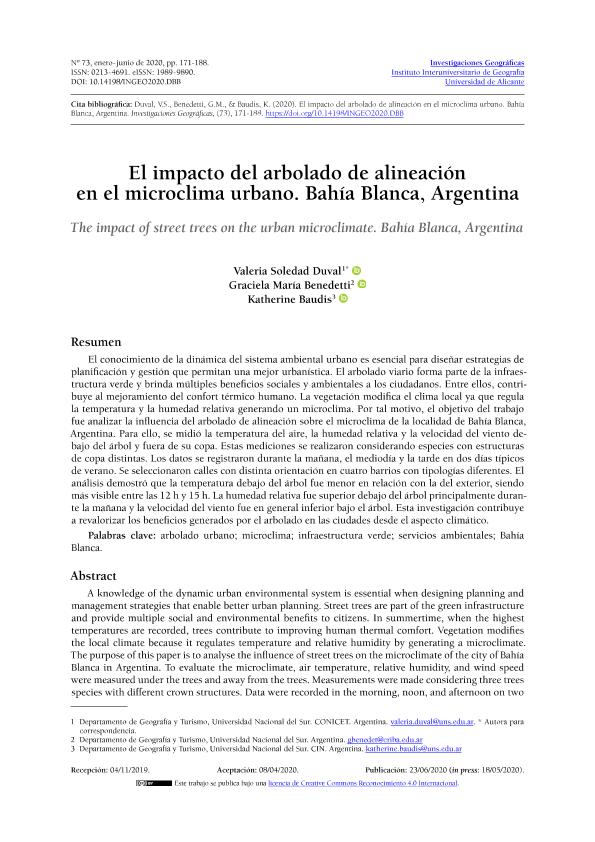Mostrar el registro sencillo del ítem
dc.contributor.author
Duval, Valeria Soledad

dc.contributor.author
Benedetti, Graciela

dc.contributor.author
Baudis, Katherine

dc.date.available
2021-04-14T13:28:30Z
dc.date.issued
2020-06
dc.identifier.citation
Duval, Valeria Soledad; Benedetti, Graciela; Baudis, Katherine; El impacto del arbolado de alineación en el microclima urbano: Bahía Blanca, Argentina; Universidad de Alicante. Instituto Interuniversitario de Geografía; Investigaciones Geográficas; 73; 6-2020; 171-188
dc.identifier.issn
0213-4691
dc.identifier.uri
http://hdl.handle.net/11336/130013
dc.description.abstract
El conocimiento de la dinámica del sistema ambiental urbano es esencial para diseñar estrategias de planificación y gestión que permitan una mejor urbanística. El arbolado viario forma parte de la infraestructura verde y brinda múltiples beneficios sociales y ambientales a los ciudadanos. Entre ellos, contribuye al mejoramiento del confort térmico humano. La vegetación modifica el clima local ya que regula la temperatura y la humedad relativa generando un microclima. Por tal motivo, el objetivo del trabajo fue analizar la influencia del arbolado de alineación sobre el microclima de la localidad de Bahía Blanca, Argentina. Para ello, se midió la temperatura del aire, la humedad relativa y la velocidad del viento debajo del árbol y fuera de su copa. Estas mediciones se realizaron considerando especies con estructuras de copa distintas. Los datos se registraron durante la mañana, el mediodía y la tarde en dos días típicos de verano. Se seleccionaron calles con distinta orientación en cuatro barrios con tipologías diferentes. El análisis demostró que la temperatura debajo del árbol fue menor en relación con la del exterior, siendo más visible entre las 12 h y 15 h. La humedad relativa fue superior debajo del árbol principalmente durante la mañana y la velocidad del viento fue en general inferior bajo el árbol. Esta investigación contribuye a revalorizar los beneficios generados por el arbolado en las ciudades desde el aspecto climático.
dc.description.abstract
A knowledge of the dynamic urban environmental system is essential when designing planning and management strategies that enable better urban planning. Street trees are part of the green infrastructure and provide multiple social and environmental benefits to citizens. In summertime, when the highest temperatures are recorded, trees contribute to improving human thermal comfort. Vegetation modifies the local climate because it regulates temperature and relative humidity by generating a microclimate. The purpose of this paper is to analyse the influence of street trees on the microclimate of the city of Bahía Blanca in Argentina. To evaluate the microclimate, air temperature, relative humidity, and wind speed were measured under the trees and away from the trees. Measurements were made considering three trees species with different crown structures. Data were recorded in the morning, noon, and afternoon on two typical summer days. Four neighbourhoods with different building typologies were selected. The streets selected had different orientations: north-south and west-east. Data analysis showed that the temperature under the trees was lower than further away from the trees. This situation was most visible between 12 noon and 3 pm. and wind speed was lower under the trees since they act as obstacles. This research evaluates the climatic benefits generated by trees in cities.
dc.format
application/pdf
dc.language.iso
spa
dc.publisher
Universidad de Alicante. Instituto Interuniversitario de Geografía
dc.rights
info:eu-repo/semantics/openAccess
dc.rights.uri
https://creativecommons.org/licenses/by/2.5/ar/
dc.subject
ARBOLADO URBANO
dc.subject
MICROCLIMA
dc.subject
INFRAESTRUCTURA VERDE
dc.subject
SERVICIOS AMBIENTALES
dc.subject
BAHÍA BLANCA
dc.subject.classification
Geoquímica y Geofísica

dc.subject.classification
Ciencias de la Tierra y relacionadas con el Medio Ambiente

dc.subject.classification
CIENCIAS NATURALES Y EXACTAS

dc.title
El impacto del arbolado de alineación en el microclima urbano: Bahía Blanca, Argentina
dc.title
The impact of street trees on the urban microclimate: Bahía Blanca, Argentina
dc.type
info:eu-repo/semantics/article
dc.type
info:ar-repo/semantics/artículo
dc.type
info:eu-repo/semantics/publishedVersion
dc.date.updated
2021-04-12T15:52:25Z
dc.identifier.eissn
1989-9890
dc.journal.number
73
dc.journal.pagination
171-188
dc.journal.pais
España

dc.journal.ciudad
Alicante
dc.description.fil
Fil: Duval, Valeria Soledad. Consejo Nacional de Investigaciones Científicas y Técnicas. Centro Científico Tecnológico Conicet - Bahía Blanca; Argentina. Universidad Nacional del Sur. Departamento de Geografía y Turismo; Argentina
dc.description.fil
Fil: Benedetti, Graciela. Universidad Nacional del Sur. Departamento de Geografía y Turismo; Argentina
dc.description.fil
Fil: Baudis, Katherine. Universidad Nacional del Sur. Departamento de Geografía y Turismo; Argentina. Consejo Interuniversitario Nacional. - Ministerio de Educación, Cultura, Ciencia y Tecnología. Consejo Interuniversitario Nacional; Argentina
dc.journal.title
Investigaciones Geográficas
dc.relation.alternativeid
info:eu-repo/semantics/altIdentifier/url/https://www.investigacionesgeograficas.com/article/view/2020-el-impacto-del-arbolado-de-alineacion-en-el-microclima-urbano-bahia-blanca-argentina
dc.relation.alternativeid
info:eu-repo/semantics/altIdentifier/url/https://doi.org/10.14198/INGEO2020.DBB
Archivos asociados
